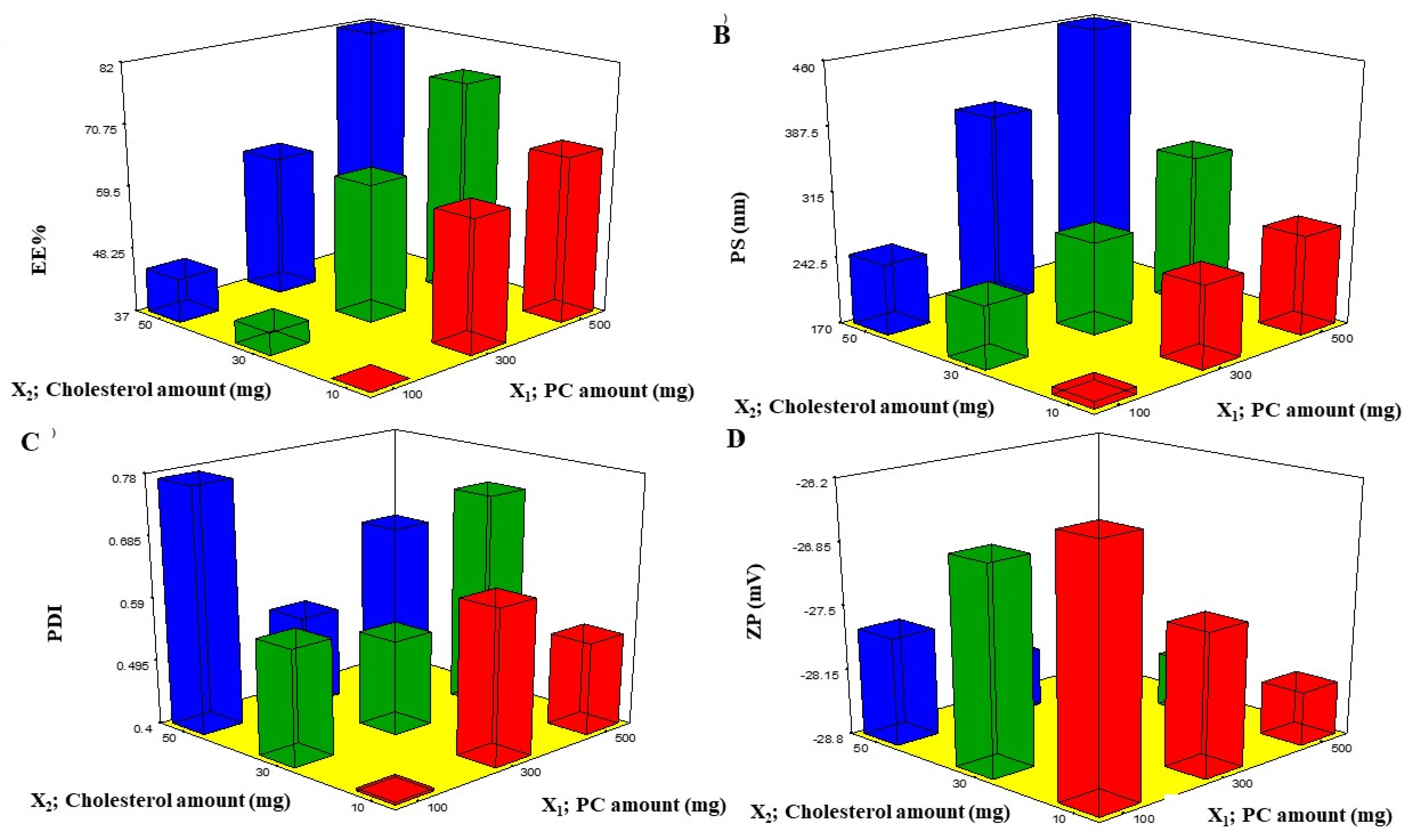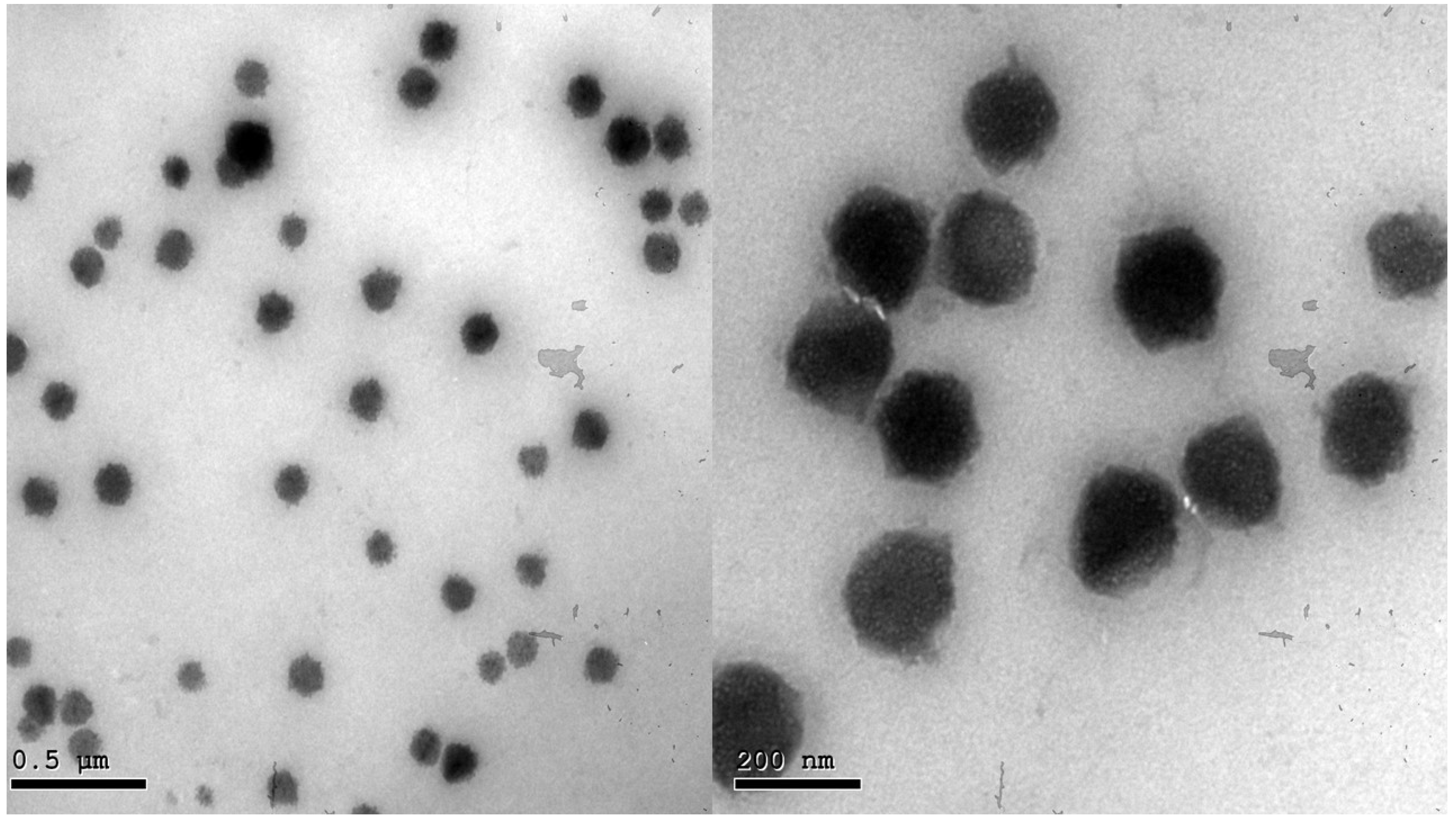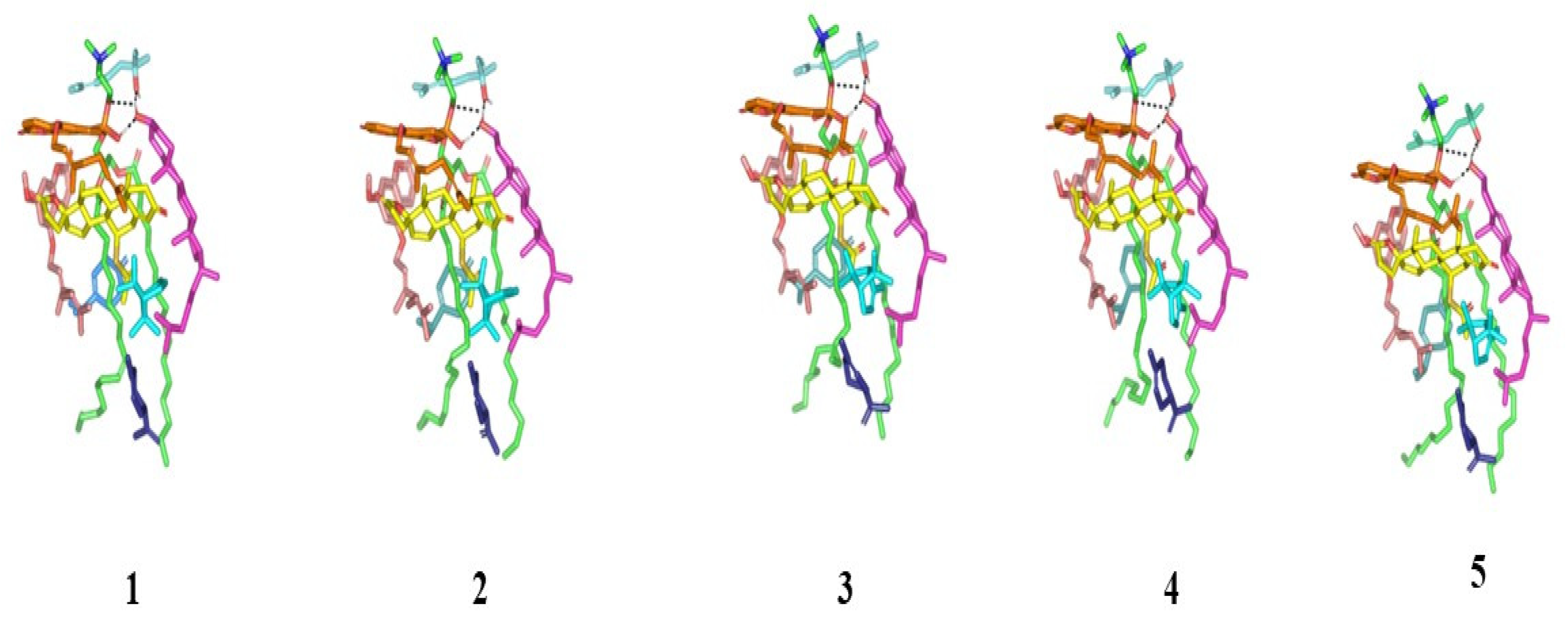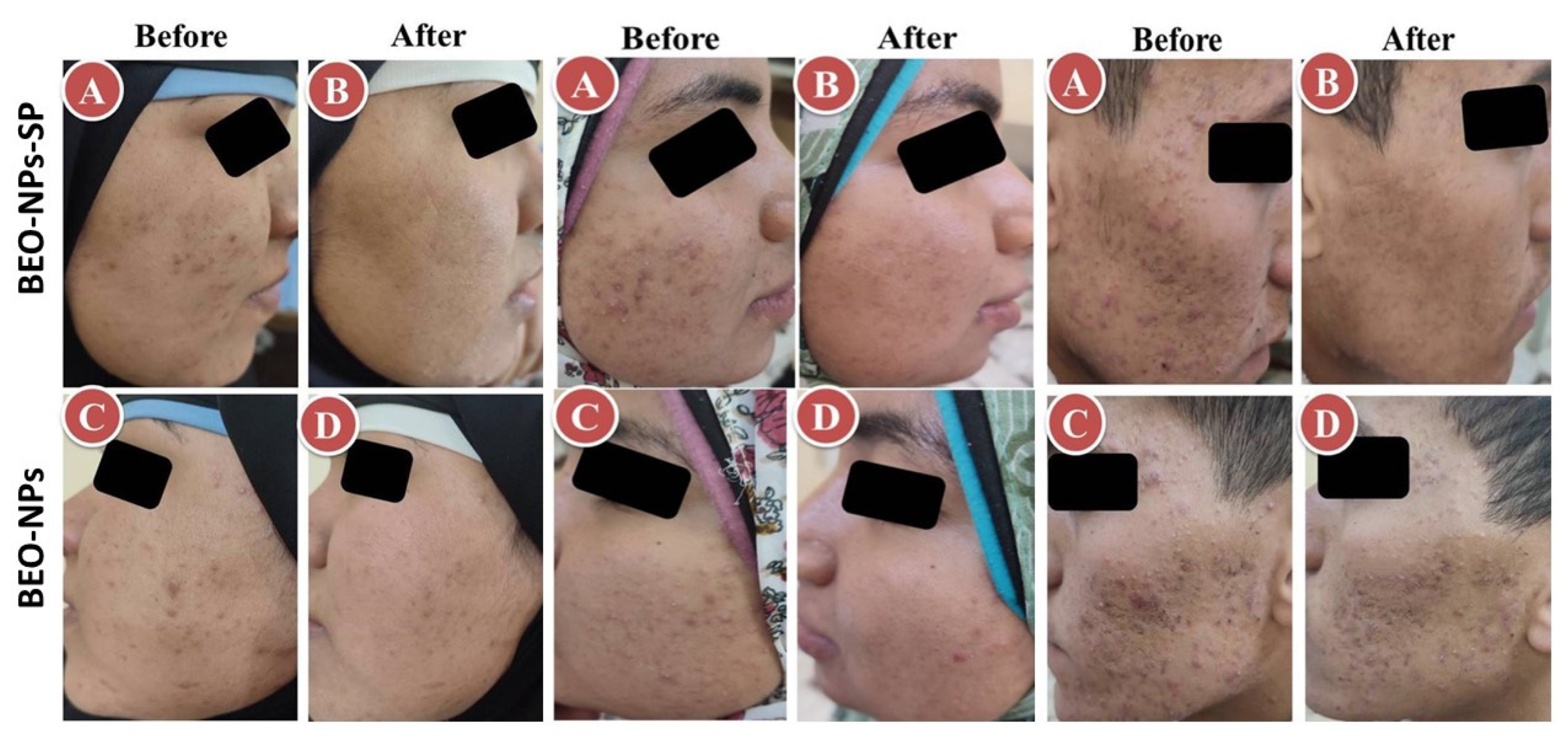Exploring the Synergistic Effect of Bergamot Essential Oil with Spironolactone Loaded Nano-Phytosomes for Treatment of Acne Vulgaris: In Vitro Optimization, In Silico Studies, and Clinical Evaluation
Abstract
:1. Introduction
2. Results and Discussion
2.1. Analysis of Full Factorial Design
2.2. Effect of Formulation Variables on the Observed Responses
2.2.1. EE%
2.2.2. PS and PDI
2.2.3. ZP
2.3. Determination of the Selected BEO-Loaded NPs Formulation
2.4. Optimization of the Selected BEO-Loaded NPs
2.5. Transmission Electron Microscopy (TEM)
2.6. Stability Study
2.7. Molecular Modelling Simulations
2.8. Clinical Evaluation of BEO-NPs and BEO-NPs-SP on Acne Patients
3. Materials and Methods
3.1. Experimental Design
3.2. Preparation of BEO-NPs
3.3. Characterization and Optimization of BEO-NPs
3.3.1. Determination of EE%
3.3.2. Determination of PS, PDI, and ZP
3.4. Selecting the BEO-NPs Formula
3.5. Optimization of the Selected BEO-Loaded NPs
3.6. Transmission Electron Microscopy (TEM)
3.7. Stability Study
3.8. Molecular Modelling Simulations
3.9. Clinical Evaluation of BEO-NPs and BEO-NPs-SP on Acne patients
3.9.1. Patients
3.9.2. Treatment Protocol
3.9.3. Statistical Analysis
4. Conclusions
Author Contributions
Funding
Institutional Review Board Statement
Informed Consent Statement
Data Availability Statement
Acknowledgments
Conflicts of Interest
References
- Amer, S.S.; Mamdouh, W.; Nasr, M.; ElShaer, A.; Polycarpou, E.; Abdel-Aziz, R.T.; Sammour, O.A. Quercetin loaded cosm-nutraceutical electrospun composite nanofibers for acne alleviation: Preparation, characterization and experimental clinical appraisal. Int. J. Pharm. 2021, 612, 121309. [Google Scholar] [CrossRef] [PubMed]
- Sun, P.; Zhao, L.; Zhang, N.; Wang, C.; Wu, W.; Mehmood, A.; Zhang, L.; Ji, B.; Zhou, F. Essential oil and juice from bergamot and sweet orange improve acne vulgaris caused by excessive androgen secretion. Mediat. Inflamm. 2020, 2020, 8868107. [Google Scholar] [CrossRef] [PubMed]
- Chutoprapat, R.; Kopongpanich, P.; Chan, L.W. A Mini-Review on Solid Lipid Nanoparticles and Nanostructured Lipid Carriers: Topical Delivery of Phytochemicals for the Treatment of Acne vulgaris. Molecules 2022, 27, 3460. [Google Scholar] [CrossRef] [PubMed]
- Scuteri, D.; Crudo, M.; Rombolà, L.; Watanabe, C.; Mizoguchi, H.; Sakurada, S.; Sakurada, T.; Greco, R.; Corasaniti, M.T.; Morrone, L.A.; et al. Antinociceptive effect of inhalation of the essential oil of bergamot in mice. Fitoterapia 2018, 129, 20–24. [Google Scholar] [CrossRef]
- Han, X.; Beaumont, C.; Stevens, N. Chemical composition analysis and in vitro biological activities of ten essential oils in human skin cells. Biochim. Open 2017, 5, 1–7. [Google Scholar] [CrossRef]
- Nasr, M.; Al-Karaki, R. Nanotechnological innovations enhancing the topical therapeutic efficacy of quercetin: A succinct review. Curr. Drug Deliv. 2020, 17, 270–278. [Google Scholar] [CrossRef]
- Amer, S.S.; Nasr, M.; Abdel-Aziz, R.T.; Moftah, N.H.; ElShaer, A.; Polycarpou, E.; Mamdouh, W.; Sammour, O. Cosm-nutraceutical nanovesicles for acne treatment: Physicochemical characterization and exploratory clinical experimentation. Int. J. Pharm. 2020, 577, 119092. [Google Scholar] [CrossRef]
- Purnamasari, N.A.D.; Dzakwan, M.; Pramukantoro, G.E.; Mauludin, R.; Elfahmi. Evaluation of myricetin nanophytosome with thin-sonication layer hydration method using ethanol and acetone solvents. Int. J. Appl. Pharm. 2020, 12, 153–157. [Google Scholar] [CrossRef]
- Vu, H.T.; Hook, S.M.; Siqueira, S.D.; Müllertz, A.; Rades, T.; McDowell, A. Are phytosomes a superior nanodelivery system for the antioxidant rutin? Int. J. Pharm. 2018, 548, 82–91. [Google Scholar] [CrossRef]
- Kelidari, H.R.; Saeedi, M.; Hajheydari, Z.; Akbari, J.; Morteza-Semnani, K.; Akhtari, J.; Valizadeh, H.; Asare-Addo, K.; Nokhodchi, A. Spironolactone loaded nanostructured lipid carrier gel for effective treatment of mild and moderate acne vulgaris: A randomized, double-blind, prospective trial. Colloids Surfaces B Biointerfaces 2016, 146, 47–53. [Google Scholar] [CrossRef]
- Salama, A.; Badran, M.M.; Elmowafy, M.; Soliman, G.M. Spironolactone-loaded leciplexes as potential topical delivery systems for female acne: In vitro appraisal and ex vivo skin permeability studies. Pharmaceutics 2019, 12, 25. [Google Scholar] [CrossRef] [PubMed] [Green Version]
- Salem, H.F.; Kharshoum, R.M.; Awad, S.M.; Mostafa, M.A.; A Abou-Taleb, H. Tailoring of retinyl palmitate-based ethosomal hydrogel as a novel nanoplatform for acne vulgaris management: Fabrication, optimization, and clinical evaluation employing a split-face comparative study. Int. J. Nanomed. 2021, 16, 4251–4276. [Google Scholar] [CrossRef] [PubMed]
- Ammar, H.; Tadros, M.I.; Salama, N.M.; Ghoneim, A.M. Ethosome-derived invasomes as a potential transdermal delivery system for vardenafil hydrochloride: Development, optimization and application of physiologically based pharmacokinetic modeling in adults and geriatrics. Int. J. Nanomed. 2020, 15, 5671–5685. [Google Scholar] [CrossRef]
- Khan, I.; Needham, R.; Yousaf, S.; Houacine, C.; Islam, Y.; Bnyan, R.; Sadozai, S.K.; Elrayess, M.A.; Elhissi, A. Impact of phospholipids, surfactants and cholesterol selection on the performance of transfersomes vesicles using medical nebulizers for pulmonary drug delivery. J. Drug Deliv. Sci. Technol. 2021, 66, 102822. [Google Scholar] [CrossRef]
- Gu, Y.; Bian, Q.; Zhou, Y.; Huang, Q.; Gao, J. Hair follicle-targeting drug delivery strategies for the management of hair follicle-associated disorders. Asian J. Pharm. Sci. 2022, 17, 333–352. [Google Scholar] [CrossRef]
- Ghasemiyeh, P.; Mohammadi-Samani, S. Potential of nanoparticles as permeation enhancers and targeted delivery options for skin: Advantages and disadvantages. Drug Des. Dev. Ther. 2020, 14, 3271–3289. [Google Scholar] [CrossRef] [PubMed]
- Albash, R.; Elmahboub, Y.; Baraka, K.; Abdellatif, M.M.; Alaa-Eldin, A.A. Ultra-deformable liposomes containing terpenes (terpesomes) loaded fenticonazole nitrate for treatment of vaginal candidiasis: Box-Behnken design optimization, comparative ex vivo and in vivo studies. Drug Deliv. 2020, 27, 1514–1523. [Google Scholar] [CrossRef]
- Moolakkadath, T.; Aqil, M.; Ahad, A.; Imam, S.S.; Iqbal, B.; Sultana, Y.; Mujeeb, M.; Iqbal, Z. Development of transethosomes formulation for dermal fisetin delivery: Box–Behnken design, optimization, in vitro skin penetration, vesicles–skin interaction and dermatokinetic studies. Artif. Cells Nanomed. Biotechnol. 2018, 46, 755–765. [Google Scholar] [CrossRef] [Green Version]
- Moolakkadath, T.; Aqil, M.; Ahad, A.; Imam, S.S.; Praveen, A.; Sultana, Y.; Mujeeb, M.; Iqbal, Z. Fisetin loaded binary ethosomes for management of skin cancer by dermal application on UV exposed mice. Int. J. Pharm. 2019, 560, 78–91. [Google Scholar] [CrossRef]
- Albash, R.; Abdellatif, M.M.; Hassan, M.; Badawi, N.M. Tailoring Terpesomes and Leciplex for the Effective Ocular Conveyance of Moxifloxacin Hydrochloride (Comparative Assessment): In-Vitro, Ex-Vivo, and In-Vivo Evaluation. Int. J. Nanomed. 2021, 16, 5247–5263. [Google Scholar] [CrossRef]
- Naguib, M.J.; Salah, S.; Abdel Halim, S.A.; Badr-Eldin, S.M. Investigating the potential of utilizing glycerosomes as a novel vesicular platform for enhancing intranasal delivery of lacidipine. Int. J. Pharm. 2020, 582, 119302. [Google Scholar] [CrossRef]
- Badawi, N.M.; Attia, Y.M.; El-Kersh, D.M.; A Hammam, O.; Khalifa, M.K. Investigating the Impact of Optimized Trans-Cinnamic Acid-Loaded PLGA Nanoparticles on Epithelial to Mesenchymal Transition in Breast Cancer. Int. J. Nanomed. 2022, 17, 733–750. [Google Scholar] [CrossRef]
- Salem, H.F.; Gamal, A.; Saeed, H.; Tulbah, A.S. The Impact of Improving Dermal Permeation on the Efficacy and Targeting of Liposome Nanoparticles as a Potential Treatment for Breast Cancer. Pharmaceutics 2021, 13, 1633. [Google Scholar] [CrossRef]
- Abd-Elsalam, W.H.; El-Helaly, S.N.; Ahmed, M.; Al-Mahallawi, A.M. Preparation of novel phospholipid-based sonocomplexes for improved intestinal permeability of rosuvastatin: In vitro characterization, dynamic simulation, Caco-2 cell line permeation and in vivo assessment studies. Int. J. Pharm. 2018, 548, 375–384. [Google Scholar] [CrossRef]
- Farag, M.M.; El Malak, N.S.A.; Yehia, S.A.; Ahmed, M.A. Hyaluronic Acid Conjugated Metformin-Phospholipid Sonocomplex: A Biphasic Complexation Approach to Correct Hypoxic Tumour Microenvironment. Int. J. Nanomed. 2021, 16, 1005–1019. [Google Scholar] [CrossRef]
- Hasan, I.Y.; Mechler, A. Analytical approaches to study domain formation in biomimetic membranes. Analyst 2017, 142, 3062–3078. [Google Scholar] [CrossRef] [PubMed]
- Ipsen, J.H.; Karlström, G.; Mourtisen, O.; Wennerström, H.; Zuckermann, M. Phase equilibria in the phosphatidylcholine-cholesterol system. Biochim. Biophys. Acta 1987, 905, 162–172. [Google Scholar] [CrossRef]
- Hasan, I.Y.; Mechler, A. Cholesterol Rich Domains Identified in Unilamellar Supported Biomimetic Membranes via Nano-Viscosity Measurements. Anal. Chem. 2016, 88, 5037–5041. [Google Scholar] [CrossRef] [PubMed]
- Ruths, M. Surface Forces, Surface Tension, and Adhesion, in Encyclopedia of Tribology; Wang, Q.J., Chung, Y.-W., Eds.; Springer: Boston, MA, USA, 2013; pp. 3435–3443. [Google Scholar]
- Israelachvili, J.N. Intermolecular and Surface Forces. In Intermolecular and Surface Forces, 3rd ed.; Academic Press: Boston, MA, USA, 2011; p. 3. [Google Scholar]
- Cristiano, M.C.; D’Avanzo, N.; Mancuso, A.; Tarsitano, M.; Barone, A.; Torella, D.; Paolino, D.; Fresta, M. Ammonium glycyrrhizinate and Bergamot essential oil co-loaded ultradeformable nanocarriers: An effective natural nanomedicine for in vivo anti-inflammatory topical therapies. Biomedicines 2022, 10, 1039. [Google Scholar] [CrossRef] [PubMed]
- Nazari, M.; Majdi, H.; Milani, M.; Abbaspour-Ravasjani, S.; Hamishehkar, H.; Lim, L.-T. Cinnamon nanophytosomes embedded electrospun nanofiber: Its effects on microbial quality and shelf-life of shrimp as a novel packaging. Food Packag. Shelf Life 2019, 21, 100349. [Google Scholar] [CrossRef]
- Shaaban, M.; Nasr, M.; Tawfik, A.A.; Fadel, M.; Sammour, O. Bergamot oil as an integral component of nanostructured lipid carriers and a photosensitizer for photodynamic treatment of vitiligo: Characterization and clinical experimentation. Expert Opin. Drug Deliv. 2020, 18, 139–150. [Google Scholar] [CrossRef] [PubMed]
- Albash, R.; El-Dahmy, R.M.; Hamed, M.I.A.; Darwish, K.M.; Alahdal, A.M.; Kassem, A.B.; Fahmy, A.M. Repurposing levocetirizine hydrochloride loaded into cationic ceramide/phospholipid composite (CCPCs) for management of alopecia: Central composite design optimization, in-silico and in-vivo studies. Drug Deliv. 2022, 29, 2784–2795. [Google Scholar] [CrossRef]
- Albash, R.; Ragaie, M.H.; El Hassab, M.A.; El-Haggar, R.; Eldehna, W.M.; Al-Rashood, S.T.; Mosallam, S. Fenticonazole nitrate loaded trans-novasomes for effective management of tinea corporis: Design characterization, in silico study, and exploratory clinical appraisal. Drug Deliv. 2022, 29, 1100–1111. [Google Scholar] [CrossRef] [PubMed]
- Soliman, S.M.; Mosallam, S.; Mamdouh, M.A.; Hussein, M.A.; El-Halim, S.M.A. Design and optimization of cranberry extract loaded bile salt augmented liposomes for targeting of MCP-1/STAT3/VEGF signaling pathway in DMN-intoxicated liver in rats. Drug Deliv. 2022, 29, 427–439. [Google Scholar] [CrossRef] [PubMed]
- Albash, R.; Fahmy, A.M.; Hamed, M.I.A.; Darwish, K.M.; El-Dahmy, R.M. Spironolactone hyaluronic acid enriched cerosomes (HAECs) for topical management of hirsutism: In silico studies, statistical optimization, ex vivo, and in vivo studies. Drug Deliv. 2021, 28, 2289–2300. [Google Scholar] [CrossRef]
- Mosallam, S.; Ragaie, M.H.; Moftah, N.H.; Elshafeey, A.H.; Abdelbary, A.A. Use of novasomes as a vesicular carrier for improving the topical delivery of terconazole: In vitro characterization, in vivo assessment and exploratory clinical experimentation. Int. J. Nanomed. 2021, 16, 119–132. [Google Scholar] [CrossRef]
- Teaima, M.H.; Eltabeeb, M.A.; El-Nabarawi, M.A.; Abdellatif, M.M. Utilization of propranolol hydrochloride mucoadhesive invasomes as a locally acting contraceptive: In-vitro, ex-vivo, and in-vivo evaluation. Drug Deliv. 2022, 29, 2549–2560. [Google Scholar] [CrossRef]
- Ferlazzo, N.; Cirmi, S.; Calapai, G.; Ventura-Spagnolo, E.; Gangemi, S.; Navarra, M. Anti-Inflammatory Activity of Citrus bergamia Derivatives: Where Do We Stand? Molecules 2016, 21, 1273. [Google Scholar] [CrossRef] [Green Version]
- Eberhardt, J.; Santos-Martins, D.; Tillack, A.F.; Forli, S. AutoDock Vina 1.2.0: New Docking Methods, Expanded Force Field, and Python Bindings. J. Chem. Inf. Model. 2021, 61, 3891–3898. [Google Scholar] [CrossRef]
- Trott, O.; Olson, A.J. AutoDock Vina: Improving the speed and accuracy of docking with a new scoring function, efficient optimization, and multithreading. J. Comput. Chem. 2010, 31, 455–461. [Google Scholar] [CrossRef]
- de Souza, A.S.; Pacheco, B.D.C.; Pinheiro, S.; Muri, E.M.F.; Dias, L.R.S.; Lima, C.H.S.; Garrett, R.; de Moraes, M.B.M.; de Souza, B.E.G.; Puzer, L. 3-Acyltetramic acids as a novel class of inhibitors for human kallikreins 5 and 7. Bioorganic Med. Chem. Lett. 2019, 29, 1094–1098. [Google Scholar] [CrossRef]
- Albuquerque, S.O.; Barros, T.G.; Dias, L.R.S.; Lima, C.H.d.S.; de Azevedo, P.H.R.; Flores, L.A.P., Jr.; Santos, E.G.D.; Loponte, H.F.; Pinheiro, S.; Dias, W.B.; et al. Biological evaluation and molecular modeling of peptidomimetic compounds as inhibitors for O-GlcNAc transferase (OGT). Eur. J. Pharm. Sci. 2020, 154, 105510. [Google Scholar] [CrossRef] [PubMed]
- Phillips, J.C.; Braun, R.; Wang, W.; Gumbart, J.; Tajkhorshid, E.; Villa, E.; Chipot, C.; Skeel, R.D.; Kalé, L.; Schulten, K. Scalable molecular dynamics with NAMD. J. Comput. Chem. 2005, 26, 1781–1802. [Google Scholar] [CrossRef] [PubMed] [Green Version]
- NilFroushzadeh, M.A.; Siadat, A.H.; Baradaran, E.; Moradi, S. Clindamycin lotion alone versus combination lotion of clindamycin phosphate plus tretinoin versus combination lotion of clindamycin phosphate plus salicylic acid in the topical treatment of mild to moderate acne vulgaris: A randomized control trial. Indian J. Dermatol. Venereol. Leprol. 2009, 75, 279–282. [Google Scholar]
- El-Mahdy, M.M.; Mohamed, E.-E.M.; Saddik, M.S.; Ali, M.F.; El-Sayed, A.M. Formulation and clinical evaluation of niosomal methylene blue for successful treatment of acne. J. Adv. Biomed. Pharm. Sci. 2020, 3, 116–126. [Google Scholar] [CrossRef]
- Mohanan, S.; Parveen, B.; Malathy, P.A.; Gomathi, N. Use of intense pulse light for acne vulgaris in Indian skin—A case series. Int. J. Dermatol. 2012, 51, 473–476. [Google Scholar] [CrossRef]
- Barakat, M.T.; Moftah, N.H.; El Khayyat, M.A.M.; Abdelhakim, Z.A. Significant reduction of inflammation and sebaceous glands size in acne vulgaris lesions after intense pulsed light treatment. Dermatol. Ther. 2017, 30, e12418. [Google Scholar] [CrossRef]






| Formulation Code | PC Amount (mg) | Cholesterol Amount (mg) | EE% | PS (nm) | PDI | ZP (mV) |
|---|---|---|---|---|---|---|
| B1 | 100 | 10 | 37.68 ± 0.97 | 178.58 ± 0.40 | 0.408 ± 0.011 | −26.52 ± 0.51 |
| B2 | 300 | 10 | 61.12 ± 1.04 | 262.80 ± 0.30 | 0.635 ± 0.063 | −27.35 ± 0.15 |
| B3 | 500 | 10 | 67.41 ± 0.69 | 280.20 ± 1.98 | 0.499 ± 0.014 | −28.01 ± 0.53 |
| B4 | 100 | 30 | 41.15 ± 0.94 | 240.58 ± 7.61 | 0.576 ± 0.093 | −26.70 ± 0.11 |
| B5 | 300 | 30 | 62.11 ± 0.65 | 274.20 ± 1.80 | 0.544 ± 0.043 | −27.35 ± 0.25 |
| B6 | 500 | 30 | 76.12 ± 1.18 | 338.70 ± 4.33 | 0.728 ± 0.010 | −28.25 ± 0.96 |
| B7 | 100 | 50 | 45.03 ± 1.65 | 249.25 ± 0.75 | 0.773 ± 0.007 | −27.70 ± 0.20 |
| B8 | 300 | 50 | 64.32 ± 2.84 | 384.50 ± 0.50 | 0.538 ± 0.048 | −28.20 ± 0.10 |
| B9 | 500 | 50 | 81.89% ± 1.25 | 459.40 ± 4.09 | 0.645 ± 0.003 | −28.70 ± 0.152 |
| Responses | EE% | PS (nm) | PDI | ZP (mV) |
|---|---|---|---|---|
| Adequate precision | 42.34 | 64.44 | 6.44 | 9.97 |
| Adjusted R2 | 0.99 | 0.99 | 0.56 | 0.82 |
| Predicted R2 | 0.97 | 0.98 | 0.10 | 0.62 |
| Significant factors | X1, X2 | X1, X2 | ---- | X1, X2 |
| Predicted value of selected formula (B3) | 67.02 | 281.5 | 0.541 | −28.25 |
| Observed value of selected formula (B3) | 67.41 | 280.2 | 0.499 | −28.01 |
| RT | LT | p Value | ||
|---|---|---|---|---|
| N = 20 | N = 20 | |||
| Com. B | Median | 8 | 10.5 | |
| Mean ± SD | 8.10 ± 3.09 | 9.65 ± 3.35 | ||
| IQR | 6.25–10.00 | 6.50–12.75 | ||
| Range | 2.00–14.00 | 4.00–14.00 | ||
| Com. A | Median | 3 | 0 | |
| Mean ± SD | 3.40 ± 2.26 | 1.20 ± 1.61 | ||
| IQR | 2.00–5.00 | 0.00–2.75 | ||
| Range | 0.00–8.00 | 0.00–5.00 | ||
| p value | p < 0.0001 | p < 0.0001 | ||
| Com. Reduction % | Median | 59.17 | 100 | p < 0.0001 |
| Mean ± SD | 63.10 ± 17.45 | 90.38 ± 12.53 | ||
| IQR | 50.00–74.11 | 78.15–100.00 | ||
| Range | 40.00–100.00 | 61.54–100.00 | ||
| Inf. B | Median | 16.5 | 14 | |
| Mean ± SD | 15.90 ± 2.10 | 13.75 ± 2.92 | ||
| IQR | 14.25–18.00 | 11.25–16.00 | ||
| Range | 11.00–18.00 | 9.00–18.00 | ||
| Inf. A | Median | 6 | 1 | |
| Mean ± SD | 5.85 ± 1.04 | 1.05 ±1.15 | ||
| IQR | 5.00–6.75 | 0.00–2.00 | ||
| Range | 4.00–8.00 | 0.00–4.00 | ||
| p value | p < 0.0001 | p < 0.0001 | ||
| Inf. Reduction % | Median | 64.29 | 93.31 | p < 0.0001 |
| Mean ± SD | 63.16 ± 4.93 | 93.37 ± 6.92 | ||
| IQR | 61.11–66.67% | 87.85–100.00% | ||
| Range | 50.00–70.59% | 77.78–100.00% | ||
| Tot. B | Median | 24 | 23.5 | |
| Mean ± SD | 24.00 ± 2.83 | 23.55 ± 4.77 | ||
| IQR | 22.00–25.75 | 20.50–27.75 | ||
| Range | 19.00–30.00 | 14.00–29.00 | ||
| Tot. A | Median | 9 | 2 | |
| Mean ± SD | 9.25 ± 1.86 | 2.25 ± 1.83 | ||
| IQR | 8.00–10.75 | 0.25–4.00 | ||
| Range | 6.00–13.00 | 0.00–6.00 | ||
| p value | p < 0.0001 | p < 0.0001 | ||
| Tot. Reduction% | Median | 61.39 | 92.59 | p < 0.0001 |
| Mean ± SD | 61.60 ± 5.24 | 91.28 ± 7.06 | ||
| IQR | 57.44–66.35 | 84.76–98.91 | ||
| Range | 52.38–70.83 | 77.78–100.00 |
| Factors (Independent Variables) | Levels | |
|---|---|---|
| X1: PC amount (mg) | 100 | 300 500 |
| X2: Cholesterol amount (mg) | 10 | 30 50 |
| Responses (dependent variables) | Constraints | |
| Y1: EE (%) | Maximize | |
| Y2: PS (nm) | Minimize | |
| Y3: PDI | Minimize | |
| Y4: ZP (mV) | Maximize | |
| Solvation State | Atomic Composition (№. of Atoms) | ||||||||||
|---|---|---|---|---|---|---|---|---|---|---|---|
| SP | PC | COL | LIM | LIN | BPI | GTP | GMC | BRG | Water | Total | |
| 100% Water | 61 | 135 | 74 | 26 | 29 | 32 | 26 | 48 | 47 | 3 × 4393 | 13,657 |
Disclaimer/Publisher’s Note: The statements, opinions and data contained in all publications are solely those of the individual author(s) and contributor(s) and not of MDPI and/or the editor(s). MDPI and/or the editor(s) disclaim responsibility for any injury to people or property resulting from any ideas, methods, instructions or products referred to in the content. |
© 2023 by the authors. Licensee MDPI, Basel, Switzerland. This article is an open access article distributed under the terms and conditions of the Creative Commons Attribution (CC BY) license (https://creativecommons.org/licenses/by/4.0/).
Share and Cite
Albash, R.; Badawi, N.M.; Hamed, M.I.A.; Ragaie, M.H.; Mohammed, S.S.; Elbesh, R.M.; Darwish, K.M.; Lashkar, M.O.; Elhady, S.S.; Mosallam, S. Exploring the Synergistic Effect of Bergamot Essential Oil with Spironolactone Loaded Nano-Phytosomes for Treatment of Acne Vulgaris: In Vitro Optimization, In Silico Studies, and Clinical Evaluation. Pharmaceuticals 2023, 16, 128. https://doi.org/10.3390/ph16010128
Albash R, Badawi NM, Hamed MIA, Ragaie MH, Mohammed SS, Elbesh RM, Darwish KM, Lashkar MO, Elhady SS, Mosallam S. Exploring the Synergistic Effect of Bergamot Essential Oil with Spironolactone Loaded Nano-Phytosomes for Treatment of Acne Vulgaris: In Vitro Optimization, In Silico Studies, and Clinical Evaluation. Pharmaceuticals. 2023; 16(1):128. https://doi.org/10.3390/ph16010128
Chicago/Turabian StyleAlbash, Rofida, Noha M. Badawi, Mohammed I. A. Hamed, Maha H. Ragaie, Sahar S. Mohammed, Rovan M. Elbesh, Khaled M. Darwish, Manar O. Lashkar, Sameh S. Elhady, and Shaimaa Mosallam. 2023. "Exploring the Synergistic Effect of Bergamot Essential Oil with Spironolactone Loaded Nano-Phytosomes for Treatment of Acne Vulgaris: In Vitro Optimization, In Silico Studies, and Clinical Evaluation" Pharmaceuticals 16, no. 1: 128. https://doi.org/10.3390/ph16010128
APA StyleAlbash, R., Badawi, N. M., Hamed, M. I. A., Ragaie, M. H., Mohammed, S. S., Elbesh, R. M., Darwish, K. M., Lashkar, M. O., Elhady, S. S., & Mosallam, S. (2023). Exploring the Synergistic Effect of Bergamot Essential Oil with Spironolactone Loaded Nano-Phytosomes for Treatment of Acne Vulgaris: In Vitro Optimization, In Silico Studies, and Clinical Evaluation. Pharmaceuticals, 16(1), 128. https://doi.org/10.3390/ph16010128







